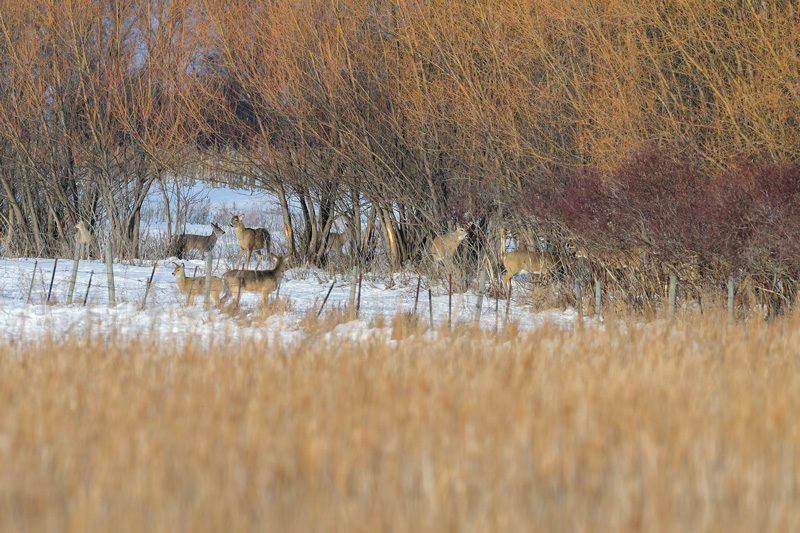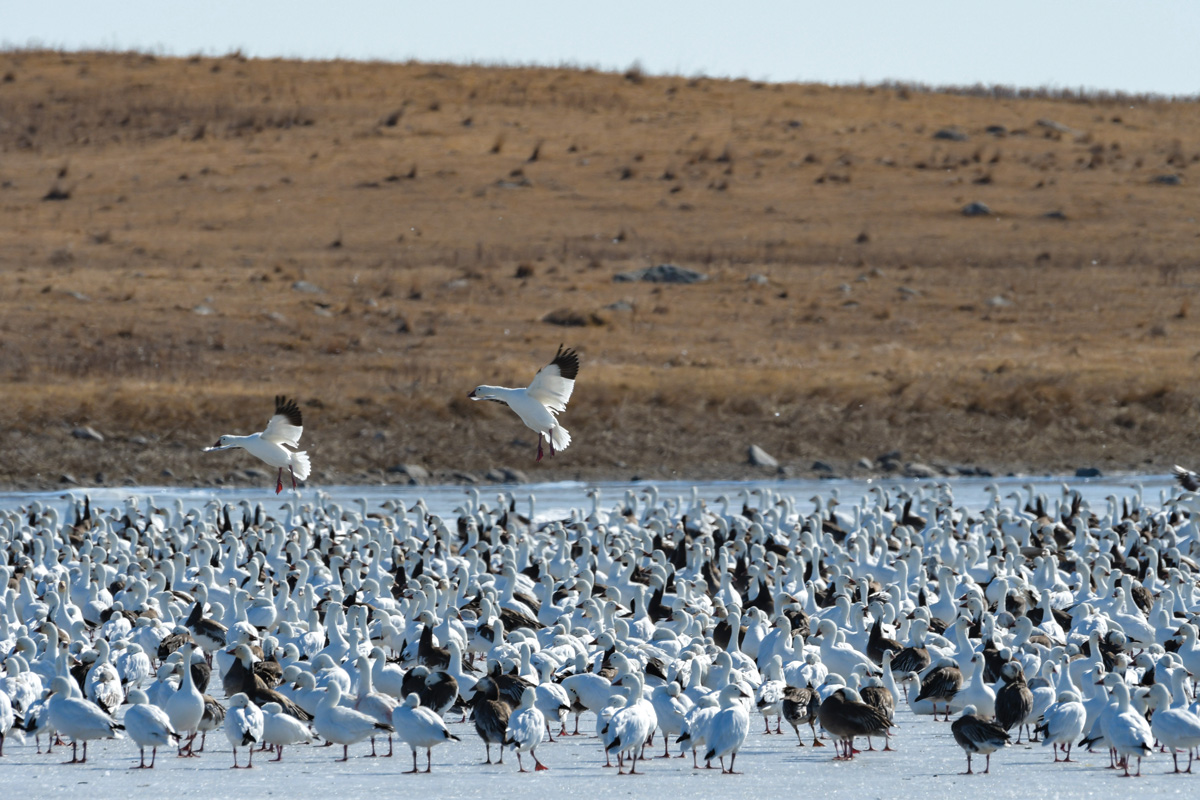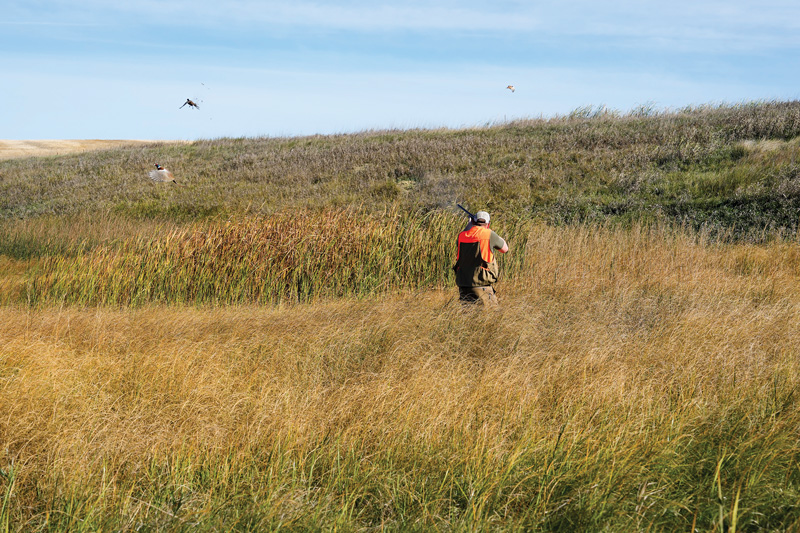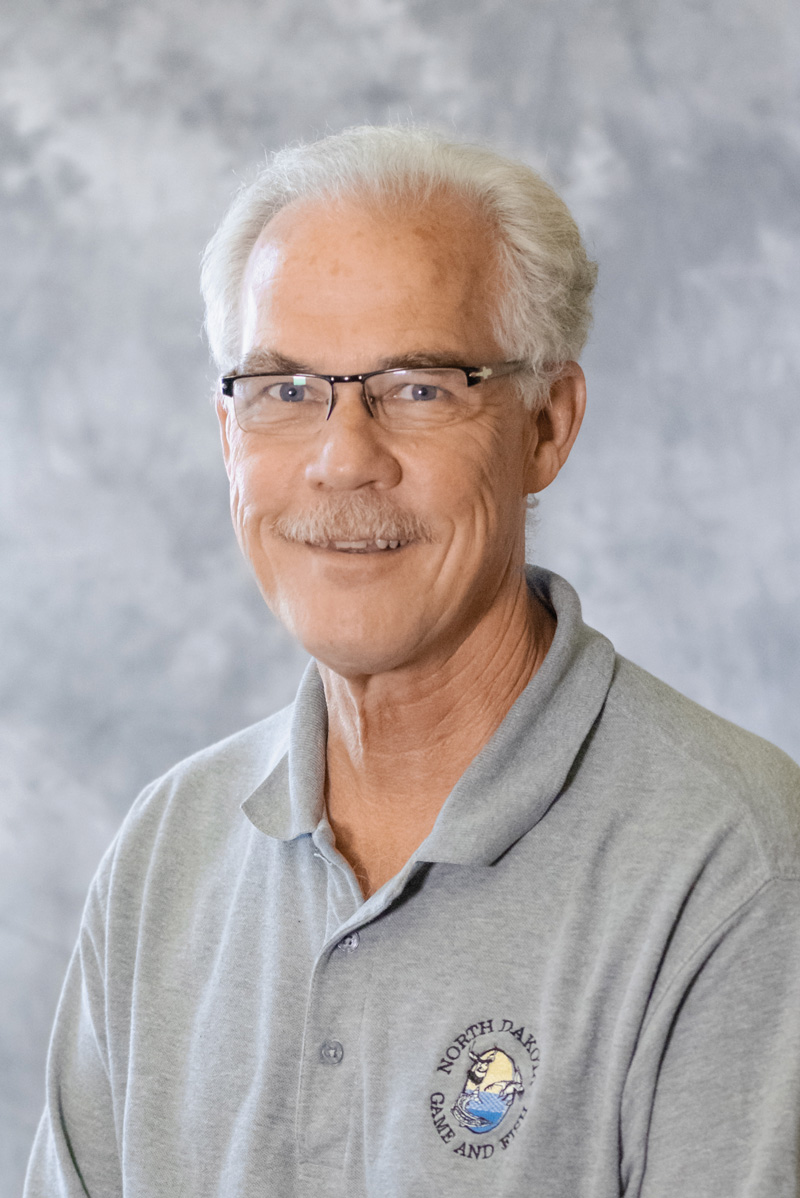
Buffaloberry Patch
Record Number of Geese Tallied in Survey
Spring Light Goose Conservation Order
Youth Conservation and Leadership Summer Camp
Record Number of Geese Tallied in Survey

The North Dakota Game and Fish Department’s annual midwinter waterfowl survey in early January was a record breaker.
During the aerial midwinter survey, one of the longest running coordinated migratory bird surveys in North America, biologists counted more than 300,000 Canada geese.
“Our old record was about 222,000 Canada geese, so we blew that out of the water,” said Mike Szymanski, Department migratory game bird management supervisor.
Compared to last year when winter came early and stayed late, there was a lot more open water along the Missouri River System to hold birds. Last winter, for example, Lake Sakakawea iced over on Dec. 18, making it one of the earliest dates for freeze up in recent years.
“We had a really nice December … a lot of areas were almost 10 degrees above average for the entire month of December,” Szymanski said. “There was a lot of open water under nice conditions, with no foraging restraints on the birds. That translated into our wintering waterfowl estimates. Last year, we really didn’t need to survey any of Lake Sakakawea because of early freeze up. But this year the lake was open from about the Van Hook Arm down to the dam and the U.S. Highway 83 causeway.”
Interestingly, biologists counted more than 9,000 snow geese during the survey.
“That was kind of surprising. We’ve always had some snow geese here and there, but most years we have zero,” Szymanski said. “To have sizable numbers like that is pretty interesting.”
Also, biologists typically see around 5,000 to 10,000 mallards during the survey. During this year’s midwinter count, the tally jumped to 43,000 birds.
While that sounds like a sizeable increase, Szymanski said the number of mallards tallied, in the grand scheme of things, was simply a drop in the bucket when it comes to continental populations.
“We really don’t have that many mallards in North Dakota during the midwinter survey,” he said.
All states in the Central Flyway participate in the midwinter survey during the same time frame to reduce the possibility of counting birds more than once.
“What we learn in the surveys is used primarily to estimate some of the species that we don’t have very good breeding count estimates for, especially arctic nesting birds,” Szymanski said. “It also helps paint a picture of waterfowl distributions, kind of in the middle of hunting season for some of the wintering states. And also changes in wintering distributions over time.”
Winter Wildlife Advice

Wildlife managers urge outdoor enthusiasts to consider where they recreate during North Dakota’s leanest months to spare already stressed animals simply trying to survive the elements.
This advice is true during any Northern Plains winter.
Game and Fish Department managers understand North Dakotans want to get outdoors and have fun in winter because we have several months of it. Even so, the tougher the winter is, it is important that people riding snowmobiles, shed hunting, cross-country skiing or doing whatever are cognizant about where wildlife are and to view them from a distance.
That means waiting to shed hunt until later in the spring so that you’re not pushing deer in and out of thermal cover where they’re trying to just conserve energy. Animals forced into the open are exposed to the elements a lot more, which adds further stress. Also, people need to realize that harassing wildlife from snowmobiles or other machines is illegal in North Dakota.
It’s common for snowmobilers and others to ride in areas where snow has accumulated, such as near shelterbelts and other wooded habitat because that’s where the drifts are, but people also must realize there could be deer or other wildlife within those areas to get out of the weather. So, every time animals are pushed from those areas, it increases the amount of energy they expend to survive the next day.
These same warnings, for shed hunters, skiers and others, also apply on Game and Fish Department owned or operated wildlife management areas where many animals gather to weather the winter months.
Spring Light Goose Conservation Order

North Dakota’s spring light goose conservation order opens February 17 and continues through May 12.
Residents must have a valid current season 2023-24 (valid through March 31) or 2024-25 (required April 1) combination license, or a small game, and general game and habitat license.
Nonresidents need a 2024 spring light goose conservation order license. The cost is $50 and is valid statewide. Nonresidents who hunt in the spring remain eligible to buy a fall season license. The spring license does not count against the 14-day fall waterfowl hunting season regulation.
In addition, nonresident youth under age 16 can purchase a license at the resident fee.
A federal duck stamp is not required for either residents or nonresidents.
Resident and nonresident licenses are available online at the North Dakota Game and Fish Department website, gf.nd.gov.
Hunters must register annually with the Harvest Information Program prior to hunting in each state. The HIP number can be obtained online. The HIP number obtained for North Dakota’s spring conservation order is also valid for North Dakota’s fall hunting season.
The spring conservation order is only open to light geese – snows, blues, and Ross’s. Species identification is important because white-fronted and Canada geese travel with light geese. The conservation order is closed to whitefronts, Canada geese, swans and all other migratory birds.
Youth Conservation and Leadership Summer Camp

The 1st Battalion of North Dakota Waterfowl Brigade will take place June 3-7 at the 4-H Center in Washburn.
NDWTFL is a hands-on, five-day, immersive learning experience for youth ages 13-17. The camp is designed to educate participants about the importance of wetland ecosystems, waterfowl biology, flock dynamics, shooting skills and safety, stewardship, public speaking, leadership development, and more.
The deadline to apply is March 15.
NDWTFL is a program of Texas Brigades, a Texas-based 501(c)(3) focused on educating and empowering adolescents to become conservation ambassadors.
Additional information and applications can be found at texasbrigades.org/applications.
Hunter Harvest Surveys Important

While North Dakota’s 2023 hunting seasons have come and gone, hunter success, or lack thereof, still matters to wildlife managers.
The North Dakota Game and Fish Department has conducted hunter harvest surveys for more than a half-century, using the findings to help manage the state’s wildlife populations.
Thousands of surveys are sent annually, and participation is strongly urged because hunter harvest plays a noted role, for example, in setting hunting license numbers for the upcoming season.
Hunters are surveyed about their hunting activity because understanding how many animals were removed from the population is an important ecological piece of information. The information collected from the hunter harvest surveys are compared against where the Department stands with its harvest objectives at any point in a given year. And that can mean, in some cases, license increases. But ultimately these surveys are important because they inform the recommendations passed along to the governor during the proclamation setting process.
Thousands of big game, small game, waterfowl, swan, turkey and furbearer questionnaires will be emailed to randomly selected hunters. A follow-up survey will be mailed to those who did not respond to the first survey.
Not everyone who, say, receives a hunter harvest survey for the 2023 deer gun season will have harvested a deer, but those hunters still need to fill them out and return their surveys.
The surveys are designed so that a random sample of hunters receive them, and it’s understood that some hunters weren’t successful, which in a lot of ways is just as important as knowing who did harvest a deer.
The hunter harvest surveys are short and take very little time to complete. A follow-up survey will be mailed to those who did not respond to the emailed survey.
The more surveys returned to the Department from hunters, the more robust the statistical information is to help produce better harvest estimates.
Big Three Lottery

Elk, moose and bighorn sheep applications must be submitted online before midnight March 27.
To apply online, visit My Account on the Game and Fish website. Paper applications are not available. Hunters who have received a license through the lottery in the past are not eligible to apply for that species again.
In 2023, 26,386 people applied for the 253 moose licenses; 24,091 applied for the 559 elk licenses; and 20,290 applied for the five bighorn sheep licenses.
Jensen Retires from Agency

Bill Jensen, longtime North Dakota Game and Fish Department employee, retired in January after 33 years with the agency.
Jensen was a big game management biologist in Bismarck at the time of his retirement.
Krebs New Fisheries Hire

Ethan Krebs was hired earlier this winter as a fisheries biological technician for the Game and Fish Department in Williston.
A graduate of Valley City State University, Krebs spent three summers as a fisheries seasonal in Riverdale and was later hired as a long-term seasonal before accepting the promotion in Williston.
Harling Wins PF Award

Nate Harling, Game and Fish Department habitat manager, received the Pheasants Forever Wildlife Partner of the Year award in January.
“From the field to the board room, to the capitol building, Nate Harling is on the frontlines of creating habitat. He’s shown time and time again that there’s no one more willing to roll up their sleeves alongside us to work through challenges and find creative solutions,” said a Pheasants Forever spokesperson. “His thoughtful way of analyzing and approaching things makes every team and project he’s committed to better. Not to mention, he’s a passionate hunter. The wildlife of North Dakota and those who care about that wildlife are lucky to have Nate Harling sharing his time, talent, and passion with us.”
